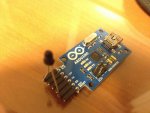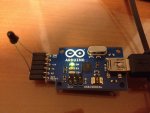- Joined
- Jul 4, 2008
- Messages
- 2,499
- Points
- 113
Well today was fairly successful. I scored a new shop in Seoul, Yongsan Electronics mall that carries just about everything one needs for building their own LPM and or Portable laser.
Details will be up on the stickies for those members in S.Korea.
Anyways. I am converting an old Hioki 3803 that has a RS232C optical connection to a Arduino digital TX signal. I disconnected the IR diode and soldiered two jumpers, one to LED + and the other to ground.
The Positive jumper was added to TX and the ground went to ground on the
USB2SERIAL.
Here is the data that came off the Hioki at 9600baud.
röòrŸay�³ should read 4.0Vdc
I am trying to research how to decipher this raw data out. What to do... .
The idea is to put the SERIAL2USB into the hioki to bypass the RS232C and go directly to digital out.
Details will be up on the stickies for those members in S.Korea.
Anyways. I am converting an old Hioki 3803 that has a RS232C optical connection to a Arduino digital TX signal. I disconnected the IR diode and soldiered two jumpers, one to LED + and the other to ground.
The Positive jumper was added to TX and the ground went to ground on the
USB2SERIAL.
Here is the data that came off the Hioki at 9600baud.
ÒÖ"‡òRåëÒÖ"‡òRåëÒÖ*>>
åëÒÖ*>>
åëgòòv>>
åëgòòv>>
åëòÒ6²v>>
åëòÒ6²v>>
åëÒÖÖ"‡òRåëÒÖÖ"‡òRåë³röòrŸay�³röòrŸay³röòrŸay�³röòrŸay³röòrŸay�³röòrŸay³röòrŸay�³röòrŸay³röòrŸay�³röòrŸay³röòrŸay�³röòrŸay³röòrŸay�³röòrŸayÒ¶¶ör>>
åëÒ¶¶ör>>
åëòòòòrŸay�òòòòrŸayòòòòrŸay�òòòòrŸayòòòòrŸay�òòòòrŸayòòòòrŸay�òòòòrŸayòòòòrŸay�òòòòrŸayòòòòrŸay�òòòòrŸayòòòòrŸay�òòòòrŸaygòòòr>>
åëgòòòr>>
åëÒv6vŸay�Òv6vŸayÒVRRrŸay�ÒVRRrŸay³röòrŸay�³röòrŸay³röòrŸay�³röòrŸay³röòrŸay�³röòrŸay³röòrŸay�³röòrŸay³röòrŸay�³röòrŸay³röòrŸay�³röòrŸay³röòrŸay�³röòr>>
åëg³ÙYÉÈìRåëg³ÙYÉÈìRåëg&Rò‡ìRåëg&Rò‡ìRåëg&gRrŸay�–ÒöRrŸay³röòrŸay�³röòrŸay³röòrŸay�³röòrŸay³röòrŸay�³röòrŸay³röòrŸay�³röòrŸaygÒ¶¶vŸay�öÒ¶¶vŸaygòrvv>>
åëgòrvv>>
åëgòòÒŸay�öòòÒŸaygòRÒvŸay�öòRÒvŸaygòòòrŸay�öòòòrŸayòòòòrŸay�òòòòrŸayòòòòrŸay�òòòòrŸayòòòòrŸay�òòòòrŸayòòòòrŸay�òòòòrŸayòòòòrŸay�òòòòrŸayòòòòrŸay�òòòòrŸayü
röòrŸay�³ should read 4.0Vdc
I am trying to research how to decipher this raw data out. What to do... .
The idea is to put the SERIAL2USB into the hioki to bypass the RS232C and go directly to digital out.
Last edited:







